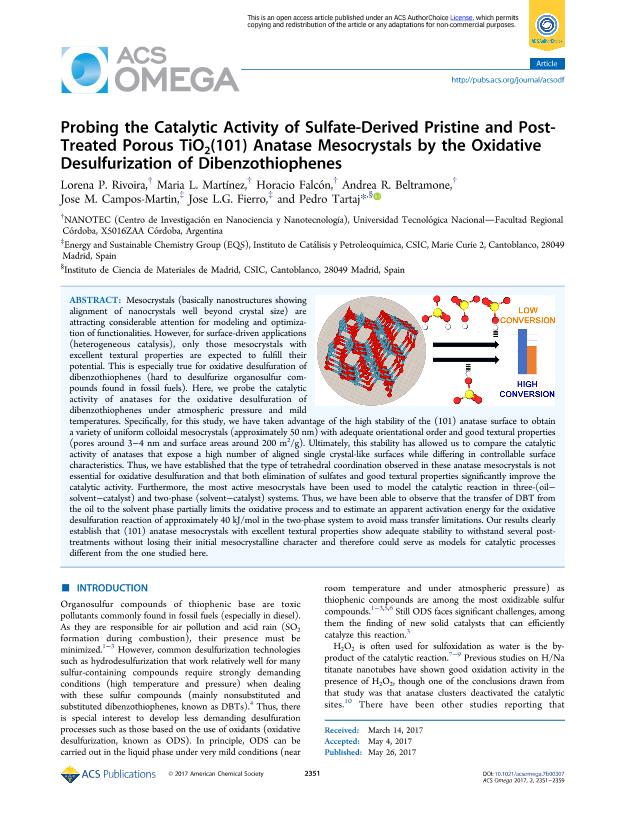Mostrar el registro sencillo del ítem
dc.contributor.author
Rivoira, Lorena Paola

dc.contributor.author
Martinez, Maria Laura

dc.contributor.author
Falcon, Horacio

dc.contributor.author
Beltramone, Andrea Raquel

dc.contributor.author
Campos-Martin, Jose M.
dc.contributor.author
García Fierro, José Luis

dc.contributor.author
Tartaj, Pedro
dc.date.available
2019-08-05T13:30:51Z
dc.date.issued
2017-05-26
dc.identifier.citation
Rivoira, Lorena Paola; Martinez, Maria Laura; Falcon, Horacio; Beltramone, Andrea Raquel; Campos-Martin, Jose M.; et al.; Probing the catalytic activity of sulfate-derived Pristine and post-treated porous TiO2(101) anatase mesocrystals by the oxidative desulfurization of dibenzothiophenes; American Chemical Society; ACS Omega; 2; 5; 26-5-2017; 2351-2359
dc.identifier.uri
http://hdl.handle.net/11336/80893
dc.description.abstract
Mesocrystals (basically nanostructures showing alignment of nanocrystals well beyond crystal size) are attracting considerable attention for modeling and optimization of functionalities. However, for surface-driven applications (heterogeneous catalysis), only those mesocrystals with excellent textural properties are expected to fulfill their potential. This is especially true for oxidative desulfuration of dibenzothiophenes (hard to desulfurize organosulfur compounds found in fossil fuels). Here, we probe the catalytic activity of anatases for the oxidative desulfuration of dibenzothiophenes under atmospheric pressure and mild temperatures. Specifically, for this study, we have taken advantage of the high stability of the (101) anatase surface to obtain a variety of uniform colloidal mesocrystals (approximately 50 nm) with adequate orientational order and good textural properties (pores around 3-4 nm and surface areas around 200 m2/g). Ultimately, this stability has allowed us to compare the catalytic activity of anatases that expose a high number of aligned single crystal-like surfaces while differing in controllable surface characteristics. Thus, we have established that the type of tetrahedral coordination observed in these anatase mesocrystals is not essential for oxidative desulfuration and that both elimination of sulfates and good textural properties significantly improve the catalytic activity. Furthermore, the most active mesocrystals have been used to model the catalytic reaction in three-(oil-solvent-catalyst) and two-phase (solvent-catalyst) systems. Thus, we have been able to observe that the transfer of DBT from the oil to the solvent phase partially limits the oxidative process and to estimate an apparent activation energy for the oxidative desulfuration reaction of approximately 40 kJ/mol in the two-phase system to avoid mass transfer limitations. Our results clearly establish that (101) anatase mesocrystals with excellent textural properties show adequate stability to withstand several post-treatments without losing their initial mesocrystalline character and therefore could serve as models for catalytic processes different from the one studied here.
dc.format
application/pdf
dc.language.iso
eng
dc.publisher
American Chemical Society
dc.rights
info:eu-repo/semantics/openAccess
dc.rights.uri
https://creativecommons.org/licenses/by-nc-sa/2.5/ar/
dc.subject
Colloidal
dc.subject
Anatase
dc.subject
Dbt
dc.subject
Ods
dc.subject.classification
Ingeniería de Procesos Químicos

dc.subject.classification
Ingeniería Química

dc.subject.classification
INGENIERÍAS Y TECNOLOGÍAS

dc.title
Probing the catalytic activity of sulfate-derived Pristine and post-treated porous TiO2(101) anatase mesocrystals by the oxidative desulfurization of dibenzothiophenes
dc.type
info:eu-repo/semantics/article
dc.type
info:ar-repo/semantics/artículo
dc.type
info:eu-repo/semantics/publishedVersion
dc.date.updated
2019-05-23T14:40:03Z
dc.identifier.eissn
2470-1343
dc.journal.volume
2
dc.journal.number
5
dc.journal.pagination
2351-2359
dc.journal.pais
Estados Unidos

dc.description.fil
Fil: Rivoira, Lorena Paola. Consejo Nacional de Investigaciones Científicas y Técnicas. Centro Científico Tecnológico Conicet - Córdoba. Centro de Investigación y Tecnología Química. Universidad Tecnológica Nacional. Facultad Regional Córdoba. Centro de Investigación y Tecnología Química; Argentina
dc.description.fil
Fil: Martinez, Maria Laura. Consejo Nacional de Investigaciones Científicas y Técnicas. Centro Científico Tecnológico Conicet - Córdoba; Argentina. Universidad Tecnológica Nacional. Facultad Regional Córdoba. Centro de Investigación en Nanociencia y Nanotecnología; Argentina
dc.description.fil
Fil: Falcon, Horacio. Universidad Tecnológica Nacional. Facultad Regional Córdoba. Centro de Investigación en Nanociencia y Nanotecnología; Argentina. Consejo Nacional de Investigaciones Científicas y Técnicas. Centro Científico Tecnológico Conicet - Córdoba; Argentina
dc.description.fil
Fil: Beltramone, Andrea Raquel. Consejo Nacional de Investigaciones Científicas y Técnicas. Centro Científico Tecnológico Conicet - Córdoba; Argentina. Universidad Tecnológica Nacional. Facultad Regional Córdoba. Centro de Investigación en Nanociencia y Nanotecnología; Argentina
dc.description.fil
Fil: Campos-Martin, Jose M.. Consejo Superior de Investigaciones Científicas; España
dc.description.fil
Fil: García Fierro, José Luis. Instituto de Catalisis y Petroleoquimica-csic; España
dc.description.fil
Fil: Tartaj, Pedro. Consejo Superior de Investigaciones Científicas. Instituto de Catálisis y Petroleoquímica; España
dc.journal.title
ACS Omega
dc.relation.alternativeid
info:eu-repo/semantics/altIdentifier/url/https://pubs.acs.org/doi/10.1021/acsomega.7b00307
dc.relation.alternativeid
info:eu-repo/semantics/altIdentifier/doi/http://dx.doi.org/10.1021/acsomega.7b00307
Archivos asociados
